fuel cap VOLVO XC70 2003 Owners Manual
[x] Cancel search | Manufacturer: VOLVO, Model Year: 2003, Model line: XC70, Model: VOLVO XC70 2003Pages: 257, PDF Size: 5.33 MB
Page 3 of 257
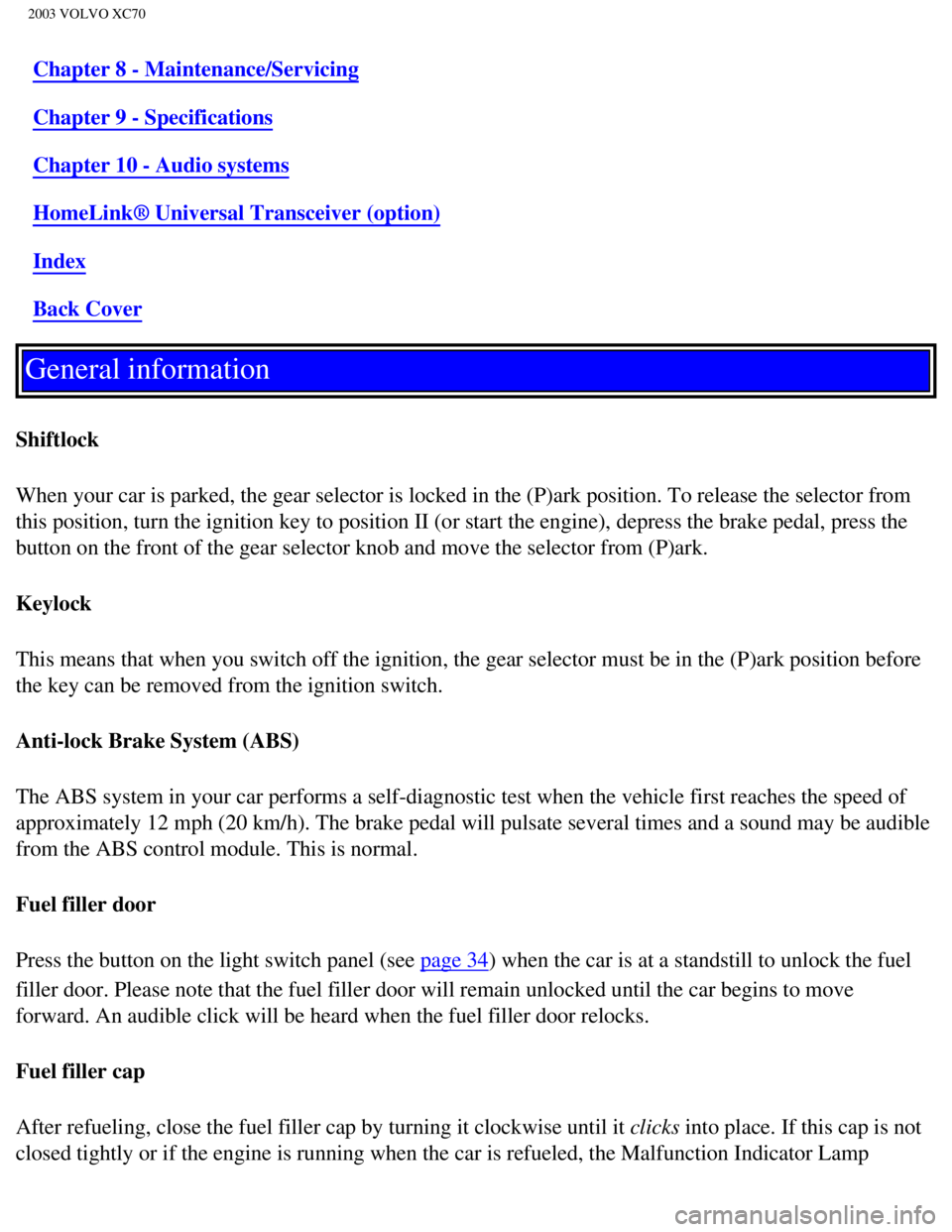
2003 VOLVO XC70
Chapter 8 - Maintenance/Servicing
Chapter 9 - Specifications
Chapter 10 - Audio systems
HomeLink® Universal Transceiver (option)
Index
Back Cover
General information
Shiftlock
When your car is parked, the gear selector is locked in the (P)ark pos\
ition. To release the selector from
this position, turn the ignition key to position II (or start the engin\
e), depress the brake pedal, press the
button on the front of the gear selector knob and move the selector from\
(P)ark.
Keylock
This means that when you switch off the ignition, the gear selector must\
be in the (P)ark position before
the key can be removed from the ignition switch.
Anti-lock Brake System (ABS)
The ABS system in your car performs a self-diagnostic test when the vehi\
cle first reaches the speed of
approximately 12 mph (20 km/h). The brake pedal will pulsate several t\
imes and a sound may be audible
from the ABS control module. This is normal.
Fuel filler door
Press the button on the light switch panel (see
page 34) when the car is at a standstill to unlock the fuel
filler door. Please note that the fuel filler door will remain unlocked \
until the car begins to move
forward. An audible click will be heard when the fuel filler door relock\
s.
Fuel filler cap
After refueling, close the fuel filler cap by turning it clockwise until\
it clicks into place. If this cap is not
closed tightly or if the engine is running when the car is refueled, the\
Malfunction Indicator Lamp
file:///K|/ownersdocs/2003/2003_XC70/03xc70_00.htm (3 of 6)12/30/2006 \
4:17:50 PM
Page 45 of 257
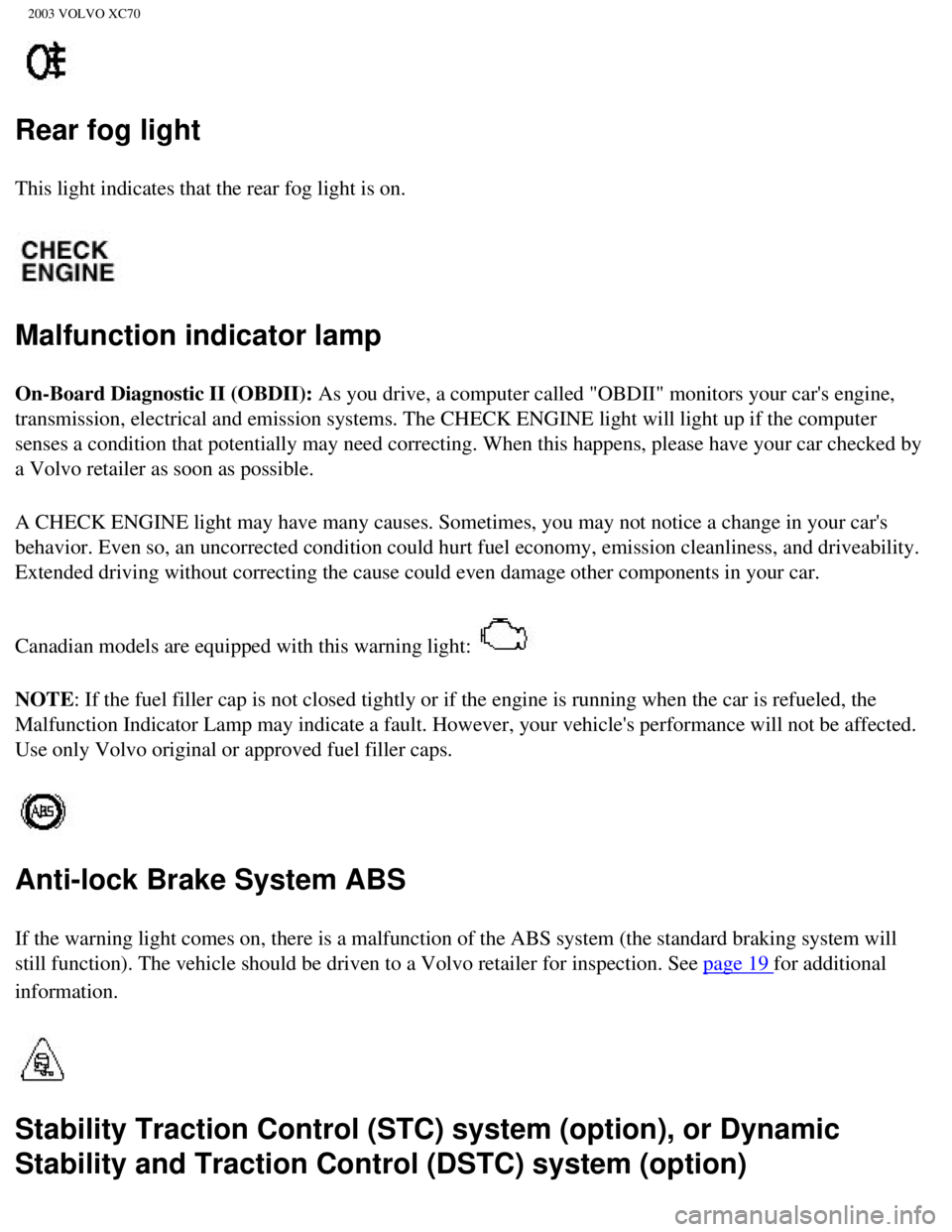
2003 VOLVO XC70
Rear fog light
This light indicates that the rear fog light is on.
Malfunction indicator lamp
On-Board Diagnostic II (OBDII): As you drive, a computer called "OBDII" monitors your car's engine,
transmission, electrical and emission systems. The CHECK ENGINE light wi\
ll light up if the computer
senses a condition that potentially may need correcting. When this happe\
ns, please have your car checked by
a Volvo retailer as soon as possible.
A CHECK ENGINE light may have many causes. Sometimes, you may not notice\
a change in your car's
behavior. Even so, an uncorrected condition could hurt fuel economy, emi\
ssion cleanliness, and driveability.
Extended driving without correcting the cause could even damage other co\
mponents in your car.
Canadian models are equipped with this warning light:
NOTE: If the fuel filler cap is not closed tightly or if the engine is runni\
ng when the car is refueled, the
Malfunction Indicator Lamp may indicate a fault. However, your vehicle's\
performance will not be affected.
Use only Volvo original or approved fuel filler caps.
Anti-lock Brake System ABS
If the warning light comes on, there is a malfunction of the ABS system \
(the standard braking system will
still function). The vehicle should be driven to a Volvo retailer for i\
nspection. See
page 19 for additional
information.
Stability Traction Control (STC) system (option), or Dynamic
Stability and Traction Control (DSTC) system (option)
file:///K|/ownersdocs/2003/2003_XC70/03xc70_02a.htm (8 of 13)12/30/200\
6 4:17:53 PM
Page 127 of 257
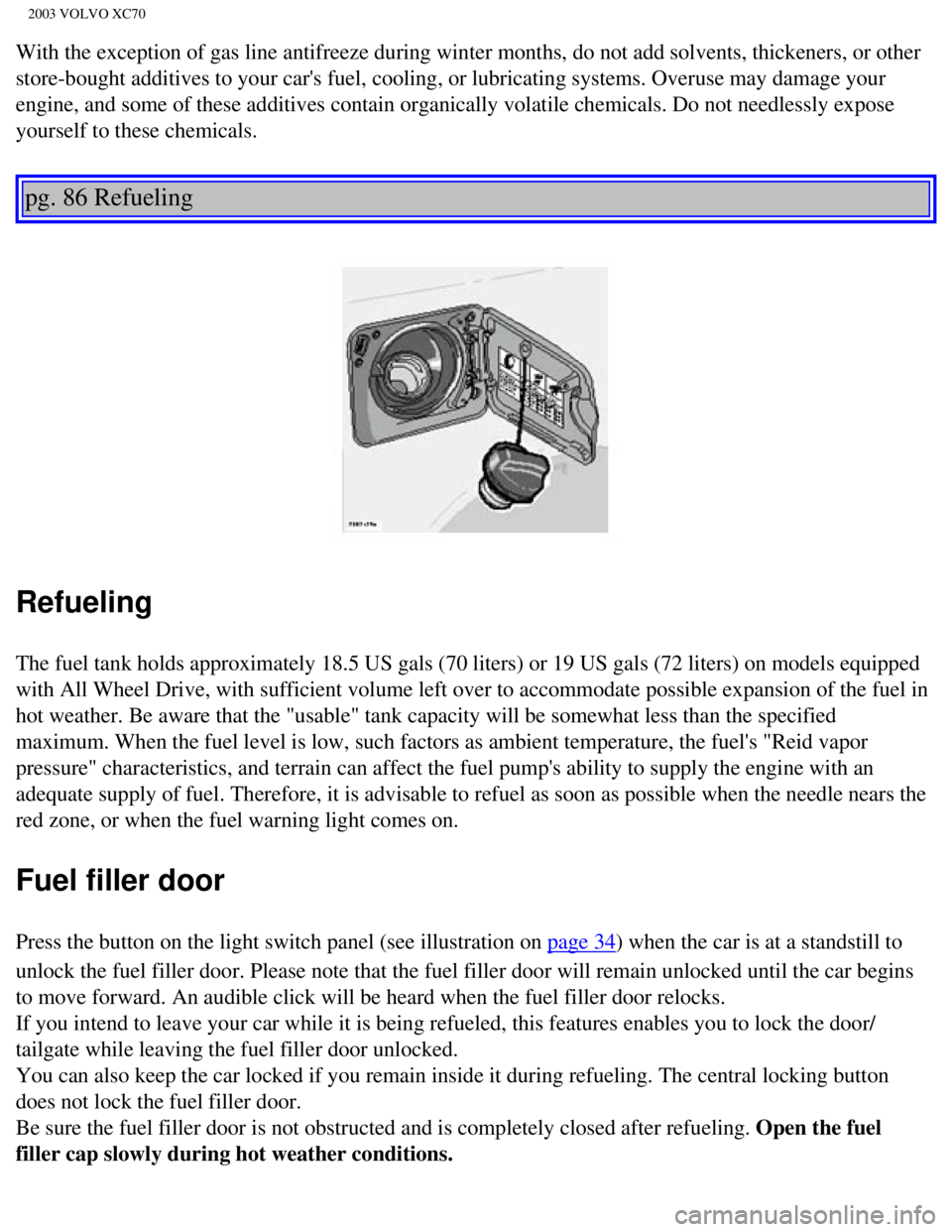
2003 VOLVO XC70
With the exception of gas line antifreeze during winter months, do not a\
dd solvents, thickeners, or other
store-bought additives to your car's fuel, cooling, or lubricating syste\
ms. Overuse may damage your
engine, and some of these additives contain organically volatile chemica\
ls. Do not needlessly expose
yourself to these chemicals.
pg. 86 Refueling
Refueling
The fuel tank holds approximately 18.5 US gals (70 liters) or 19 US ga\
ls (72 liters) on models equipped
with All Wheel Drive, with sufficient volume left over to accommodate po\
ssible expansion of the fuel in
hot weather. Be aware that the "usable" tank capacity will be somewhat l\
ess than the specified
maximum. When the fuel level is low, such factors as ambient temperature\
, the fuel's "Reid vapor
pressure" characteristics, and terrain can affect the fuel pump's abilit\
y to supply the engine with an
adequate supply of fuel. Therefore, it is advisable to refuel as soon as\
possible when the needle nears the
red zone, or when the fuel warning light comes on.
Fuel filler door
Press the button on the light switch panel (see illustration on page 34) when the car is at a standstill to
unlock the fuel filler door. Please note that the fuel filler door will \
remain unlocked until the car begins
to move forward. An audible click will be heard when the fuel filler doo\
r relocks.
If you intend to leave your car while it is being refueled, this feature\
s enables you to lock the door/
tailgate while leaving the fuel filler door unlocked.
You can also keep the car locked if you remain inside it during refuelin\
g. The central locking button
does not lock the fuel filler door.
Be sure the fuel filler door is not obstructed and is completely closed \
after refueling. Open the fuel
filler cap slowly during hot weather conditions.
file:///K|/ownersdocs/2003/2003_XC70/03xc70_06a.htm (4 of 22)12/30/200\
6 4:17:59 PM
Page 128 of 257
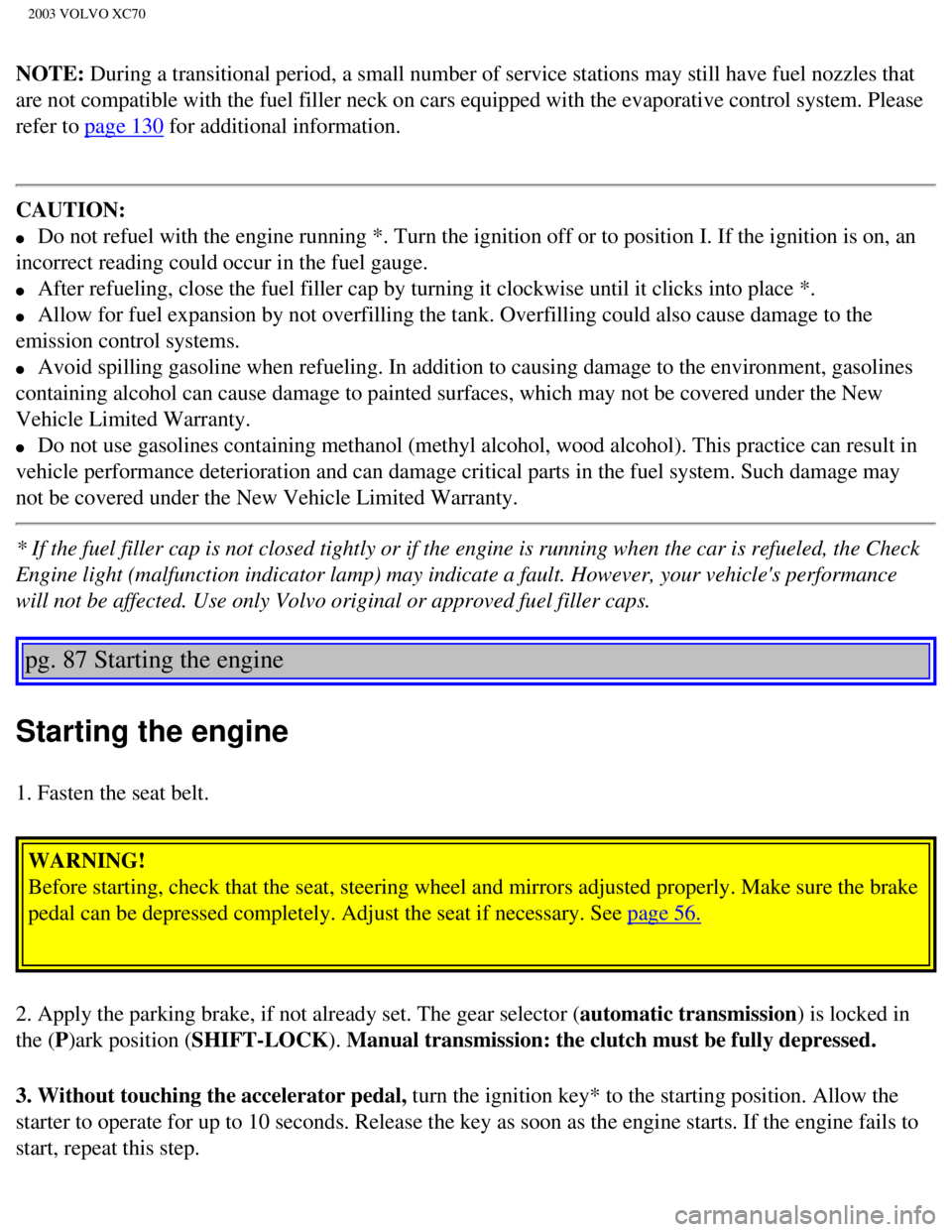
2003 VOLVO XC70
NOTE: During a transitional period, a small number of service stations may sti\
ll have fuel nozzles that
are not compatible with the fuel filler neck on cars equipped with the e\
vaporative control system. Please
refer to
page 130 for additional information.
CAUTION:
l Do not refuel with the engine running *. Turn the ignition off or to pos\
ition I. If the ignition is on, an
incorrect reading could occur in the fuel gauge.
l After refueling, close the fuel filler cap by turning it clockwise until\
it clicks into place *.
l Allow for fuel expansion by not overfilling the tank. Overfilling could \
also cause damage to the
emission control systems.
l Avoid spilling gasoline when refueling. In addition to causing damage to\
the environment, gasolines
containing alcohol can cause damage to painted surfaces, which may not b\
e covered under the New
Vehicle Limited Warranty.
l Do not use gasolines containing methanol (methyl alcohol, wood alcohol)\
. This practice can result in
vehicle performance deterioration and can damage critical parts in the f\
uel system. Such damage may
not be covered under the New Vehicle Limited Warranty.
* If the fuel filler cap is not closed tightly or if the engine is runni\
ng when the car is refueled, the Check
Engine light (malfunction indicator lamp) may indicate a fault. Howeve\
r, your vehicle's performance
will not be affected. Use only Volvo original or approved fuel filler ca\
ps.
pg. 87 Starting the engine
Starting the engine
1. Fasten the seat belt.
WARNING!
Before starting, check that the seat, steering wheel and mirrors adjuste\
d properly. Make sure the brake
pedal can be depressed completely. Adjust the seat if necessary. See
page 56.
2. Apply the parking brake, if not already set. The gear selector (automatic transmission) is locked in
the (P)ark position (SHIFT-LOCK). Manual transmission: the clutch must be fully depressed.
3. Without touching the accelerator pedal, turn the ignition key* to the starting position. Allow the
starter to operate for up to 10 seconds. Release the key as soon as the \
engine starts. If the engine fails to
start, repeat this step.
file:///K|/ownersdocs/2003/2003_XC70/03xc70_06a.htm (5 of 22)12/30/200\
6 4:17:59 PM
Page 140 of 257
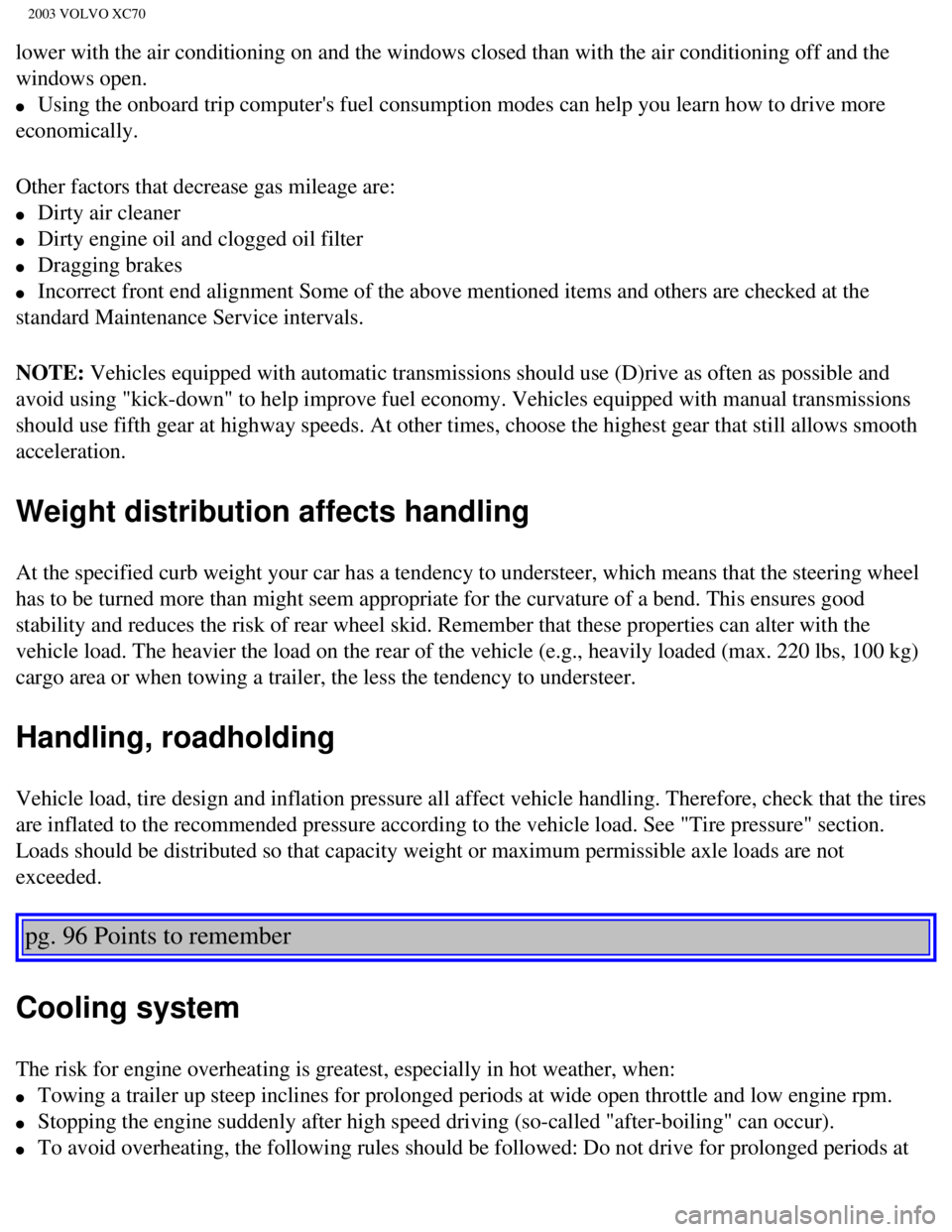
2003 VOLVO XC70
lower with the air conditioning on and the windows closed than with the \
air conditioning off and the
windows open.
l Using the onboard trip computer's fuel consumption modes can help you le\
arn how to drive more
economically.
Other factors that decrease gas mileage are:
l Dirty air cleaner
l Dirty engine oil and clogged oil filter
l Dragging brakes
l Incorrect front end alignment Some of the above mentioned items and othe\
rs are checked at the
standard Maintenance Service intervals.
NOTE: Vehicles equipped with automatic transmissions should use (D)rive as o\
ften as possible and
avoid using "kick-down" to help improve fuel economy. Vehicles equipped \
with manual transmissions
should use fifth gear at highway speeds. At other times, choose the high\
est gear that still allows smooth
acceleration.
Weight distribution affects handling
At the specified curb weight your car has a tendency to understeer, whic\
h means that the steering wheel
has to be turned more than might seem appropriate for the curvature of a\
bend. This ensures good
stability and reduces the risk of rear wheel skid. Remember that these p\
roperties can alter with the
vehicle load. The heavier the load on the rear of the vehicle (e.g., he\
avily loaded (max. 220 lbs, 100 kg)
cargo area or when towing a trailer, the less the tendency to understeer\
.
Handling, roadholding
Vehicle load, tire design and inflation pressure all affect vehicle hand\
ling. Therefore, check that the tires
are inflated to the recommended pressure according to the vehicle load. \
See "Tire pressure" section.
Loads should be distributed so that capacity weight or maximum permissib\
le axle loads are not
exceeded.
pg. 96 Points to remember
Cooling system
The risk for engine overheating is greatest, especially in hot weather, \
when:
l Towing a trailer up steep inclines for prolonged periods at wide open th\
rottle and low engine rpm.
l Stopping the engine suddenly after high speed driving (so-called "after\
-boiling" can occur).
l To avoid overheating, the following rules should be followed: Do not dri\
ve for prolonged periods at
file:///K|/ownersdocs/2003/2003_XC70/03xc70_06a.htm (17 of 22)12/30/20\
06 4:18:00 PM
Page 153 of 257

2003 VOLVO XC70
Cold weather precautions
If you wish to check your car before the approach of cold weather, the f\
ollowing advice is worth noting:
l Make sure that the engine coolant contains 50 percent antifreeze. Any ot\
her mixture will reduce
freeze protection. This gives protection against freezing down to -31°\
F (-35°C). See section "Coolant".
The use of "recycled" antifreeze is not approved by Volvo. Different typ\
es of antifreeze must not
be mixed.
l Volvo recommends using only genuine Volvo antifreeze in your car's radia\
tor. Your local Volvo
retailer stocks plenty of Volvo engine coolant to protect your car durin\
g cold weather.
l Try to keep the fuel tank well filled - this prevents the formation of condensation in the tank. \
In
addition, in extremely cold weather conditions it is worthwhile to add f\
uel line de-icer before refueling.
l The viscosity of the engine oil is important. Oil with low viscosity (thinner oil) improves cold-
weather starting as well as decreasing fuel consumption while the engine\
is warming up. For winter use,
5W-30 oil, particularly the synthetic type *, is recommended. Be sure to\
use good quality oil but do not
use this cold-weather oil for hard driving or in warm weather. See section "Engine oil" for more
information.
l The load placed on the battery is greater during the winter since the windshield wipers, lighting, etc\
.
are used more often. Moreover, the capacity of the battery decreases as \
the temperature drops. In very
cold weather, a poorly charged battery can freeze and be damaged. It is \
therefore advisable to check the
state of charge more frequently and spray an anti-rust oil on the batter\
y posts.
l Volvo recommends the use of snow tires on all four wheels for winter dri\
ving - see section "Wheels
and tires".
l To prevent the washer fluid reservoir from freezing, add washer solvents\
containing antifreeze (see
page 130 for the location of the washer fluid reservoir). This is important sin\
ce dirt is often splashed on
the windshield during winter driving, requiring the frequent use of the \
washers and wipers. The Volvo
Washer Solvent should be diluted as follows:
Down to 14° F (-10° C): 1 part washer solvent and 4 parts water \
Down to 5° F (-15° C): 1 part washer solvent and 3 parts water
Down to 0° F (-18° C): 1 part washer solvent and 2 parts water
Down to -18° F (-28° C): 1 part washer solvent and 1 part water \
l Use Volvo Teflon Lock Spray in the locks.
NOTE: Avoid the use of de-icing sprays as they can cause damage to the locks.
W Winter/Wet driving mode - enhanced vehicle traction
l Mode W will only function if the gear selector is in the (D)rive posit\
ion.
l Press the button at the base of the gear selector to engage/disengage th\
is driving mode (see
illustration).
l An LED in the button will light up to indicate that W is engaged and this will also be displayed in the
instrument panel (see
page 27).
l This mode may be selected for starting/moving off on slippery roads.
file:///K|/ownersdocs/2003/2003_XC70/03xc70_06b.htm (8 of 10)12/30/200\
6 4:18:00 PM
Page 187 of 257

2003 VOLVO XC70
pg. 130 Fuel/emissions systems
Fuel system
The fuel system continually compensates for variation in engine load, sp\
eed and temperature. A mass air
flow sensor continuously measures the inducted air and makes rapid adjus\
tments for changes in air
temperature and density, to balance fuel economy, emissions, and engine \
power requirements.
Heated oxygen sensor
This is an emission control system designed to reduce emissions and impr\
ove fuel economy. The heated
oxygen sensor monitors the composition of the exhaust gases leaving the \
engine. The exhaust gas
analysis is fed into an electronic module. This adjusts the air/fuel rat\
io to improve combustion and
reduce the three major pollutants (hydrocarbons, carbon monoxide, and o\
xides of nitrogen (NOx)) via a
three-way catalytic converter.
Crankcase ventilation
The engine is provided with positive crankcase ventilation which prevent\
s crankcase gases from being
released into the atmosphere. Instead, the crankcase gases are routed to\
the intake manifold and
cylinders.
PremAir®
On the surface of the radiator in the engine compartment, there is a spe\
cial coating called PremAir®.
PremAir® works as a catalytic converter, converting most of the ozone\
passing through the radiator into
oxygen, thereby reducing harmful ground-level ozone.
Evaporative control system
The car is equipped with an evaporative control system, which prevents g\
asoline vapor from being
released into the atmosphere.
The system consists of a fuel tank with filler pipe and cap, two rollove\
r valves, a Fill Limit Vent Valve
(FLVV), vapor vent lines, a charcoal canister, a purge line, and a pur\
ge control valve and engine
connections. In addition, there is a pressure sensor connected to the fu\
el tank and a filter-protected
Canister Close Valve (CCV) on the atmospheric side of the canister, fo\
r system diagnosis.
The gasoline vapor is channeled through the rollover valves and the FLVV\
via the vapor vent lines into
the charcoal canister, where it is stored. When the engine is started, t\
he gasoline vapor is drawn from the
file:///K|/ownersdocs/2003/2003_XC70/03xc70_08b.htm (1 of 16)12/30/200\
6 4:18:04 PM
Page 188 of 257
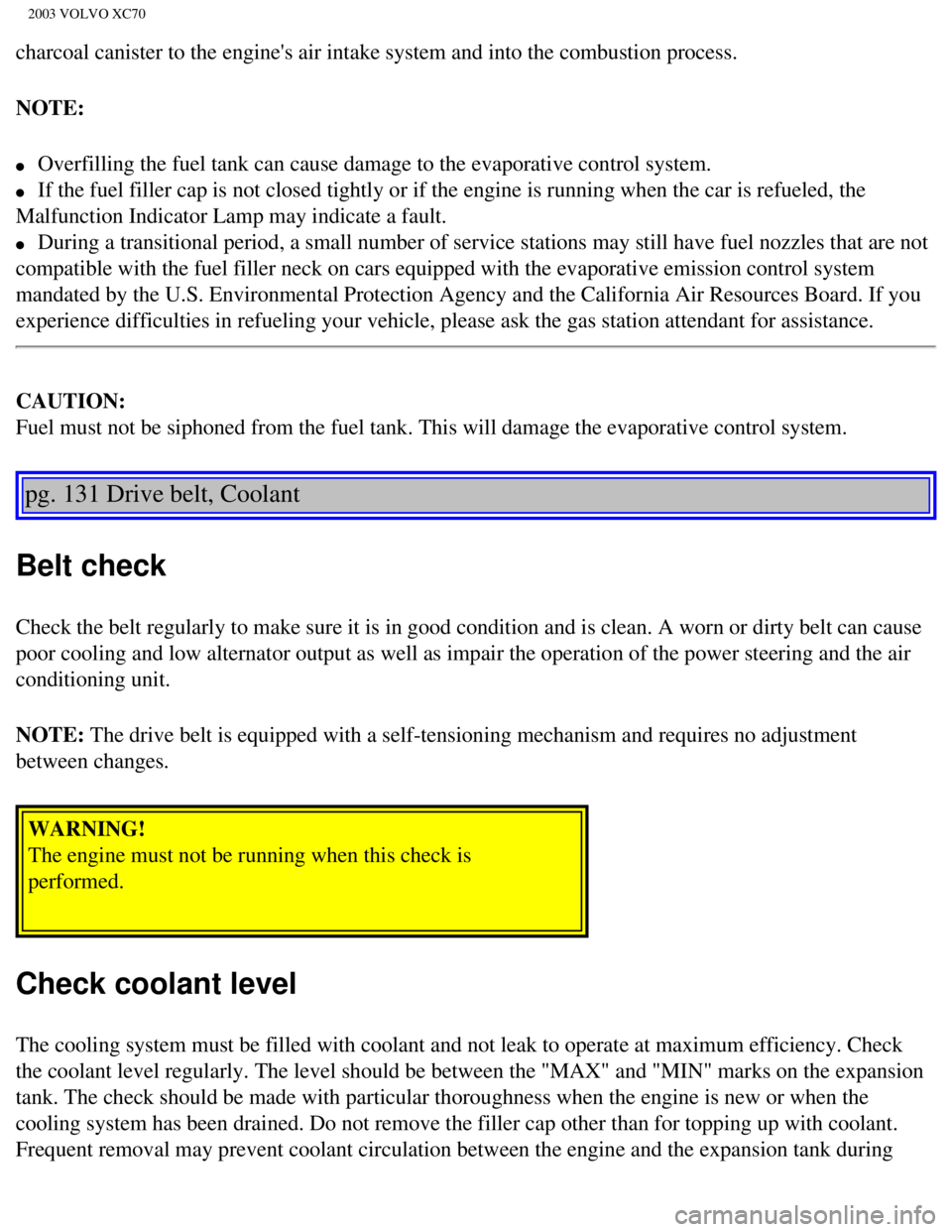
2003 VOLVO XC70
charcoal canister to the engine's air intake system and into the combust\
ion process.
NOTE:
l Overfilling the fuel tank can cause damage to the evaporative control sy\
stem.
l If the fuel filler cap is not closed tightly or if the engine is running\
when the car is refueled, the
Malfunction Indicator Lamp may indicate a fault.
l During a transitional period, a small number of service stations may sti\
ll have fuel nozzles that are not
compatible with the fuel filler neck on cars equipped with the evaporati\
ve emission control system
mandated by the U.S. Environmental Protection Agency and the California \
Air Resources Board. If you
experience difficulties in refueling your vehicle, please ask the gas st\
ation attendant for assistance.
CAUTION:
Fuel must not be siphoned from the fuel tank. This will damage the evapo\
rative control system.
pg. 131 Drive belt, Coolant
Belt check
Check the belt regularly to make sure it is in good condition and is cle\
an. A worn or dirty belt can cause
poor cooling and low alternator output as well as impair the operation o\
f the power steering and the air
conditioning unit.
NOTE: The drive belt is equipped with a self-tensioning mechanism and requires\
no adjustment
between changes.
WARNING!
The engine must not be running when this check is
performed.
Check coolant level
The cooling system must be filled with coolant and not leak to operate a\
t maximum efficiency. Check
the coolant level regularly. The level should be between the "MAX" and "\
MIN" marks on the expansion
tank. The check should be made with particular thoroughness when the eng\
ine is new or when the
cooling system has been drained. Do not remove the filler cap other than\
for topping up with coolant.
Frequent removal may prevent coolant circulation between the engine and \
the expansion tank during
file:///K|/ownersdocs/2003/2003_XC70/03xc70_08b.htm (2 of 16)12/30/200\
6 4:18:04 PM
Page 190 of 257

2003 VOLVO XC70
more often when the vehicle is driven under dirty and dusty conditions. \
The cartridge cannot be cleaned,
and should always be replaced with a new one.
Fuel filter
The fuel filter should be replaced at 105,000 miles (168,000 km) or at\
120,000 miles (193,000 km) for
the 2.5T engine on AWD models. The filter is replaced as a complete unit\
. Replace more frequently if
contaminated fuel is introduced into the tank, or if there is reason to \
suspect that this has occurred.
Fuel system, including filler cap, tank and lines and
connections
The ability of the fuel system to contain hydrocarbons depends upon a le\
ak-free system. Inspect fuel
lines every 30,000 miles (48,000 km).Check for proper sealing of the f\
uel filler cap which contains "O"
ring seals.
NOTE: If the fuel filler cap is not closed tightly or if the engine is running\
when the car is refueled, the
Check Engine light (Malfunction indicator) may indicate a fault. Howev\
er, your vehicle's performance
will not be affected. Use only Volvo original or approved fuel filler ca\
ps.
Timing belt
For proper functioning of the vehicle and its emission control systems, \
the timing belt and belt tensioner
must be replaced every 105,000 miles (168,000 km) or at 120,000 miles \
(193,000 km) for the 2.5T
engine on AWD models. Engine damage will occur if the belt fails.
PCV system
(on turbocharged models)
The nipple in the intake manifold and the filter at the end of the PCV h\
ose in the air cleaner should be
inspected and cleaned at 105,000 miles (168,000 km) and thereafter, ag\
ain at 150,000 mile (240,000 km)
intervals.
Spark plugs
The spark plugs should be replaced every 60,000 miles (96,000 km) unde\
r normal driving conditions.
City driving or fast highway driving may necessitate replacement sooner.\
Under normal driving conditions, spark plugs require no maintenance betw\
een replacement intervals.
file:///K|/ownersdocs/2003/2003_XC70/03xc70_08b.htm (4 of 16)12/30/200\
6 4:18:04 PM
Page 193 of 257
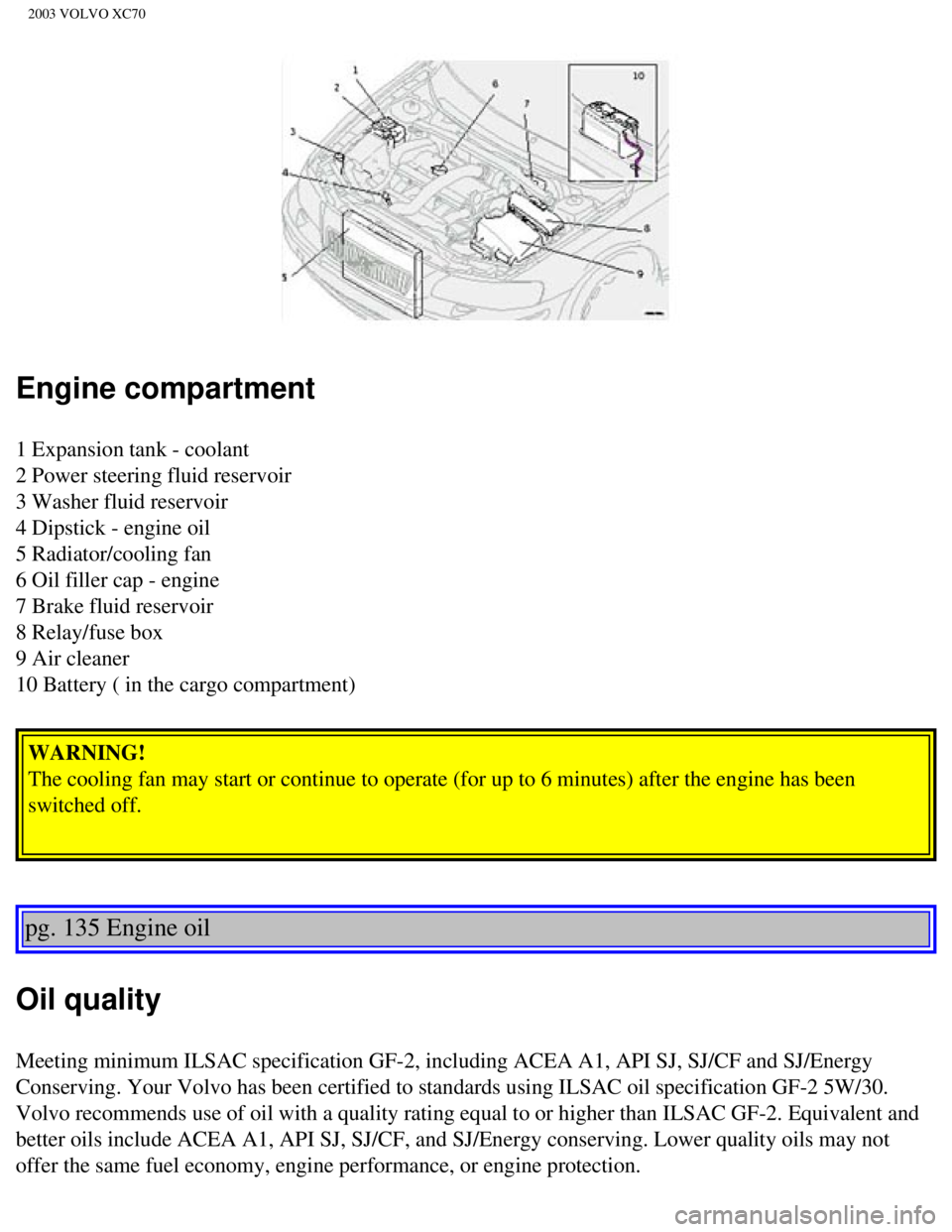
2003 VOLVO XC70
Engine compartment
1 Expansion tank - coolant
2 Power steering fluid reservoir
3 Washer fluid reservoir
4 Dipstick - engine oil
5 Radiator/cooling fan
6 Oil filler cap - engine
7 Brake fluid reservoir
8 Relay/fuse box
9 Air cleaner
10 Battery ( in the cargo compartment) WARNING!
The cooling fan may start or continue to operate (for up to 6 minutes)\
after the engine has been
switched off.
pg. 135 Engine oil
Oil quality
Meeting minimum ILSAC specification GF-2, including ACEA A1, API SJ, SJ/\
CF and SJ/Energy
Conserving. Your Volvo has been certified to standards using ILSAC oil s\
pecification GF-2 5W/30.
Volvo recommends use of oil with a quality rating equal to or higher tha\
n ILSAC GF-2. Equivalent and
better oils include ACEA A1, API SJ, SJ/CF, and SJ/Energy conserving. Lo\
wer quality oils may not
offer the same fuel economy, engine performance, or engine protection. \
file:///K|/ownersdocs/2003/2003_XC70/03xc70_08b.htm (7 of 16)12/30/200\
6 4:18:04 PM